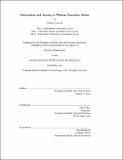Polarization and toxicity in political discourse online
Author(s)
Saveski, Martin.
Download1227784169-MIT.pdf (2.196Mb)
Other Contributors
Program in Media Arts and Sciences (Massachusetts Institute of Technology)
Advisor
Deb K. Roy.
Terms of use
Metadata
Show full item recordAbstract
The web and social media promised to fundamentally change the public sphere by democratizing access to information and lowering barriers for participation in public discourse. While some of these expectations have been met, we have also seen the negative effects of the web and social media, amplifying people's tendency to self-sort and polarize, and providing a platform for uncivil public discourse. In this thesis, we focus on two phenomena, toxicity and polarization in political discourse online. In the first part of this thesis, we study media outlets' role in political polarization online, mainly, how the language they use to promote their content influences the political diversity of their audience. We track the engagement with tweets posted by media outlets over three years (556k tweets, 104M retweets) and model the relationship between the tweet text and the political diversity of the audience. We build a tool that integrates our model and helps journalists craft tweets engaging to a politically diverse audience, guided by the model predictions. To test the real-world impact of the tool, we partner with the PBS documentary series Frontline and run a series of advertising experiments on Twitter. We find that in five out of the seven experiments, the tweets selected by our model were indeed engaging to a more politically diverse audience, illustrating the effectiveness of our tool. In the second part of this thesis, we study the relationship between the structure and the toxicity in political conversations on Twitter. We collect data on conversations prompted by tweets posted by news outlets and politicians running in the 2018 US midterm elections (1.18M conversations, 58.5M tweets). To investigate the link between structure and toxicity, we analyze the conversations at the individual, dyad, and group levels. We also consider two prediction tasks: (i) whether the conversation as a whole will become more or less toxic, and (ii) whether the next reply, posted by a specific user, will be toxic. We demonstrate that the structural characteristics of a conversation can be used to detect early signs of toxicity, both at the individual and the group level.
Description
Thesis: Ph. D., Massachusetts Institute of Technology, School of Architecture and Planning, Program in Media Arts and Sciences, September, 2020 Cataloged from student-submitted PDF of thesis. Includes bibliographical references (pages 165-176).
Date issued
2020Department
Program in Media Arts and Sciences (Massachusetts Institute of Technology)Publisher
Massachusetts Institute of Technology
Keywords
Program in Media Arts and Sciences